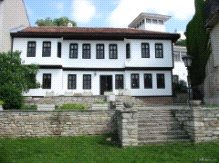

The Ethnographic Museum in the town of Balchik is located near the Historical Museum. Beautiful two-storey house in old style, which belonged to a grain merchant, today houses the Ethnographic Museum. The house was built in 60s of the XIXth century. The Museum keeps a variety of preserves authentic objects, cloths and typical local ornaments, and and various tools.
The first floor of the Ethnographic Museum hosts an exhibition of various handicrafts. You can see exhibits from the cooperage craft, such as various woodworking tools. Various sewing tools such as thimbles, irons, scissors, measurement units an other instruments related to the production of clothes are exposed. The museum exhibited striped beautiful handmade clothes typical for this region.
This region is known for its copper craftsmanship. Here are exposed vessels for liquids, such as mugs, ments, drums and also cooking pots: pans, trays, pots and other utensils. Copper products exhibited at the Ethnographic Museum dates back to the eighteenth century. The tool work exclusively exposed titled: “Dikanya” for striking cereals and cut foliage is of exclusive interest. “Dikanya” is pulled by cattle being led by a man, who stays on top, playing the main weight.
The second floor of the Ethnographic Museum presents handmade costumes typical for Dobrogea region. More impressiveare the Dobrogea fabrics. Investing his talent, artistic taste, the sense of harmony and beauty, the Bulgarian woman creates a variety of beautiful colors and fabrics and ornamentd for domestic consumption and for house decoration. Various decorations are a natural addition to cloths: for adorning the head (forehead decorations, flickering, pendants, decorations under the chin, ears, pins, earrings), for neck (necklaces), for hands (bracelets and rings), for waist – straps and buckles. Weaving was one of the main livelihood of the people of this region. There are exposed many beautiful fabrics with various embroideries. There are presented carding for processing wool, spinster, reels, forks and even the rare horizontal loom.
A rich collection of jewelry in separate windows is arranged. Each window shows visitors the ornaments for door decoration, jewelry like rings and bracelets for the hands. A variety of waist ornaments, such as various metal straps and more is shown.
The library is also located in the Ethnographic Museum, which has preserved more than 1,500 works and also stored various collections of books on topics like: pottery, wrought iron, copper, jewelry and apparel, and more.
The house museum is located in a beautiful garden planted with different flowers and bushes showing great interest from visitors. There are resting places where you can enjoy the beauty and style the Ethnographic Museum emits.
